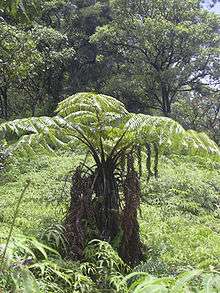Cibotium
| Cibotium | |
|---|---|
 | |
| Hāpuʻu ʻiʻi (Cibotium menziesii) | |
| Scientific classification | |
| Kingdom: | Plantae |
| Division: | Pteridophyta |
| Class: | Polypodiopsida/Pteridopsida (disputed) |
| Order: | Cyatheales |
| Family: | Cibotiaceae sensu Smith et al. (2006) |
| Genus: | Cibotium Kaulf. (1820) |
| Species | |
|
See text. | |
Cibotium (from the Greek kibootion, meaning chest or box), also known as manfern[1], is a genus of 11 species of tropical tree ferns.
Distribution
Species of the genus are distributed fairly narrowly in Hawaiʻi (four species, plus a hybrid, collectively known as hāpuʻu), Southeast Asia (five species), and the cloud forests of Central America and Mexico (two species). The natural habitat of Cibotium is among the dripping trees and stream gullies of the rainforests on Hawaiʻi's windward volcanic slopes.
The fossil record indicates that the genus was once a part of the boreotropical flora found in Europe, eastern North America, and western Asia. Fossilized Cibotium oregonense was found near Medford, Oregon, and fossilized Cibotium iwatense was found in Iwate, Japan.[2]
No publicly accessible Cibotium collections are growing outdoors in the United Kingdom, but two glasshouse collections are kept at the Royal Botanic Gardens, Kew, and the RBG Edinburgh in Scotland. Specimens of Cibotium regale in the Royal Greenhouses of Laeken are visible to the public when the glasshouses open in May.
Uses
Cibotium glaucum, from Hawaiʻi, is the most frequently encountered Cibotium species in the horticultural trade, along with its sibling species Cibotium chamissoi and the large-growing Cibotium menziesii. They are sometimes seen in California garden designs.
Cibotium barometz is best known for its role in ancient medicine. In traditional Chinese medicine, it is used as an anti-inflammatory and an anodyne; its rhizome hairs are used in Malaysia and China as a styptic for wounds.[3] It is still exported from Malaysia for this purpose.[4] Hair-covered pieces of the rhizome, with bud stalks imitating legs, were used to lend credence to the medieval legend of the Vegetable Lamb of Tartary, a half-sheep, half-plant hybrid.[5]
Threats
Pressure on Hawaiian Cibotium habitats comes from development encroaching on the forested areas, especially the more accessible, lower-lying areas which are commercially attractive for land clearance. A less obvious threat comes from an invasive introduced tree fern species: Cyathea cooperi (the most popular garden tree fern in the United States), which has escaped from the islands' suburban gardens and now outcompetes the endemic flora. Wind-blown spores from this rapidly growing Australian import can migrate many miles into pristine Cibotium forests. This is a fairly recent phenomenon, but one which may eventually have grave consequences for the tree fern ecosystem in Hawaiʻi.
Species
Cibotium taxonomy has been subject to much confusion and revision. Some of the species currently listed in the literature seem to be synonyms or local-variant subspecies.
- Cibotium arachnoideum
- Cibotium assamicum
- Cibotium barometz (L.) J.Sm. – Scythian lamb (China, western Malay Peninsula)
- Cibotium chamissoi Kaulf. – Hawaiian tree fern, Hāpuʻu ʻiʻi[6]
- Cibotium cumingii Kunze, 1841 (Philippines, Taiwan)
- Cibotium glaucum (Sm.) Hook. & Arn. – Hawaiian tree fern, Hāpuʻu pulu[7]
- Cibotium guatemalense
- Cibotium horridum
- †Cibotium iwatense Ogura
- Cibotium menziesii Hook. & Arn., 1844 – Hawaiian tree fern, Hāpuʻu ʻiʻi
- Cibotium nealiae – Hawaiian tree fern, Hāpuʻu
- †Cibotium oregonense Barrington[8]
- Cibotium regale – Royal cibotium
- Cibotium schiedei – Mexican tree fern
- Cibotium splendens
- Cibotium sumatranum
References
- ↑ https://plants.usda.gov/core/profile?symbol=CIBOT
- ↑ Barrington, D. (1993). Ecological and Historical Factors in Fern Biogeography. Journal of Biogeography, 20(3), 275-279. doi:10.2307/2845635
- ↑ Lim, T. K. (2016). "Cibotiaceae". Edible Medicinal and Non-Medicial Plants. 10, Modified Stems, Roots, Bulbs. Springer. p. 88. ISBN 9789401772754.
- ↑ Kathirithamby-Wells, Jeyamalar (2005). Nature and Nation: Forests and Development in Peninsular Malaysia. Honolulu: University of Hawai'i Press. p. 340. ISBN 0824828631.
- ↑ Large, Mark F.; Braggins, John E. (2004). Tree Ferns. Portland, Oregon: Timber Press. p. 360. ISBN 9780881926309.
- ↑ Little Jr., Elbert L.; Roger G. Skolmen (1989). "Hāpuʻu-ʻiʻi, Hawaiian treefern" (PDF). United States Forest Service.
- ↑ Little Jr., Elbert L.; Roger G. Skolmen (1989). "Hāpuʻu pulu, Hawaiian treefern" (PDF). United States Forest Service.
- ↑ Barrington, D. (1983). Cibotium oregonense: An Eocene Tree-Fern Stem and Petioles with Internal Structure. American Journal of Botany, 70(8), 1118-1124. Retrieved from http://www.jstor.org/stable/2443281
- Smith, A.R., K.M. Pryer, E. Schuettpelz, P. Korall, H. Schneider & P.G. Wolf 2006. "A classification for extant ferns" (PDF). Archived from the original (PDF) on 2008-02-26. (420 KiB) Taxonomy 55(3): 705–731.
External links
| Wikimedia Commons has media related to Cibotium. |